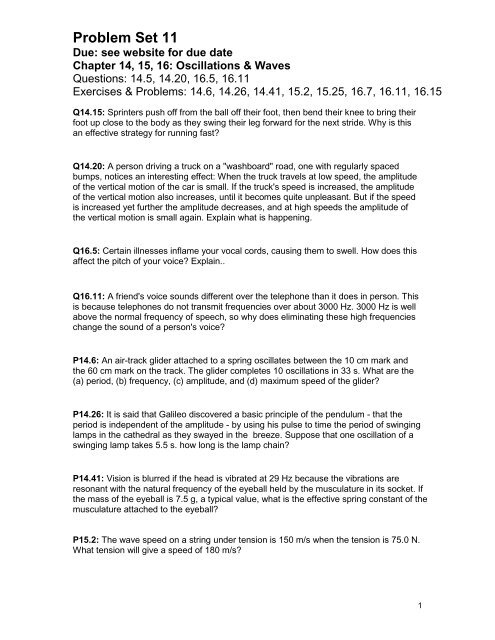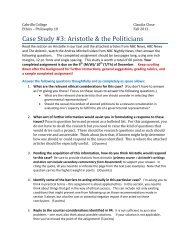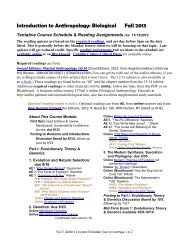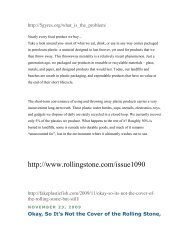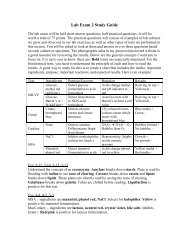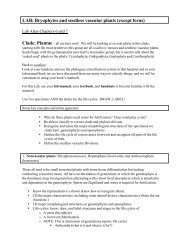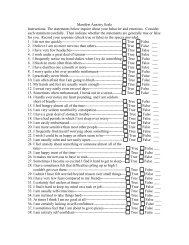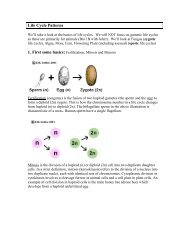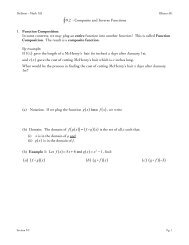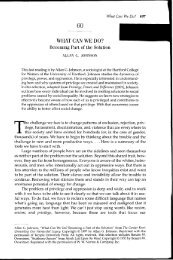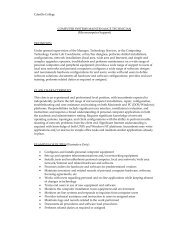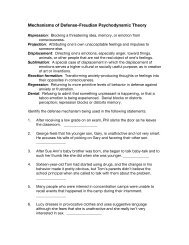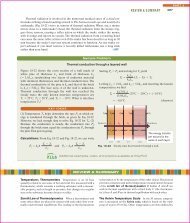Chapter 14,15,16: Oscillations & Waves - Cabrillo College
Chapter 14,15,16: Oscillations & Waves - Cabrillo College
Chapter 14,15,16: Oscillations & Waves - Cabrillo College
You also want an ePaper? Increase the reach of your titles
YUMPU automatically turns print PDFs into web optimized ePapers that Google loves.
Problem Set 11<br />
Due: see website for due date<br />
<strong>Chapter</strong> <strong>14</strong>, <strong>15</strong>, <strong>16</strong>: <strong>Oscillations</strong> & <strong>Waves</strong><br />
Questions: <strong>14</strong>.5, <strong>14</strong>.20, <strong>16</strong>.5, <strong>16</strong>.11<br />
Exercises & Problems: <strong>14</strong>.6, <strong>14</strong>.26, <strong>14</strong>.41, <strong>15</strong>.2, <strong>15</strong>.25, <strong>16</strong>.7, <strong>16</strong>.11, <strong>16</strong>.<strong>15</strong><br />
Q<strong>14</strong>.<strong>15</strong>: Sprinters push off from the ball off their foot, then bend their knee to bring their<br />
foot up close to the body as they swing their leg forward for the next stride. Why is this<br />
an effective strategy for running fast?<br />
Q<strong>14</strong>.20: A person driving a truck on a "washboard" road, one with regularly spaced<br />
bumps, notices an interesting effect: When the truck travels at low speed, the amplitude<br />
of the vertical motion of the car is small. If the truck's speed is increased, the amplitude<br />
of the vertical motion also increases, until it becomes quite unpleasant. But if the speed<br />
is increased yet further the amplitude decreases, and at high speeds the amplitude of<br />
the vertical motion is small again. Explain what is happening.<br />
Q<strong>16</strong>.5: Certain illnesses inflame your vocal cords, causing them to swell. How does this<br />
affect the pitch of your voice? Explain..<br />
Q<strong>16</strong>.11: A friend's voice sounds different over the telephone than it does in person. This<br />
is because telephones do not transmit frequencies over about 3000 Hz. 3000 Hz is well<br />
above the normal frequency of speech, so why does eliminating these high frequencies<br />
change the sound of a person's voice?<br />
P<strong>14</strong>.6: An air-track glider attached to a spring oscillates between the 10 cm mark and<br />
the 60 cm mark on the track. The glider completes 10 oscillations in 33 s. What are the<br />
(a) period, (b) frequency, (c) amplitude, and (d) maximum speed of the glider?<br />
P<strong>14</strong>.26: It is said that Galileo discovered a basic principle of the pendulum - that the<br />
period is independent of the amplitude - by using his pulse to time the period of swinging<br />
lamps in the cathedral as they swayed in the breeze. Suppose that one oscillation of a<br />
swinging lamp takes 5.5 s. how long is the lamp chain?<br />
P<strong>14</strong>.41: Vision is blurred if the head is vibrated at 29 Hz because the vibrations are<br />
resonant with the natural frequency of the eyeball held by the musculature in its socket. If<br />
the mass of the eyeball is 7.5 g, a typical value, what is the effective spring constant of the<br />
musculature attached to the eyeball?<br />
P<strong>15</strong>.2: The wave speed on a string under tension is <strong>15</strong>0 m/s when the tension is 75.0 N.<br />
What tension will give a speed of 180 m/s?<br />
1
P<strong>15</strong>.25:<br />
a. Telephone signals are often transmitted over long distances by microwaves. What is<br />
the frequency of microwave radiation with a wavelength of 3.0 cm?<br />
b. Microwave signals are beamed between two mountaintops 50 km apart. How long<br />
does it take a signal to travel from one mountaintop to the other?<br />
P<strong>16</strong>.7: A 2.0-m-long string is fixed at both ends and tightened until the wave speed is 40<br />
m/s. What is the frequency of the standing wave shown in the figure?<br />
P<strong>16</strong>.11:<br />
a. What are the three longest wavelengths for standing waves on a 240-m-long string<br />
that is fixed at both ends?<br />
b. If the frequency of the second-longest wavelength is 50.0 Hz, what is the frequency<br />
of the third-longest wavelength?<br />
P<strong>16</strong>.<strong>15</strong>: The lowest note on a grand piano has a frequency of 27.5 Hz. The entire string<br />
is 2.00 m long and has a mass of 400 g. The vibrating section of the string is 1.90 m<br />
long. What tension is needed to tune this string properly?<br />
2


